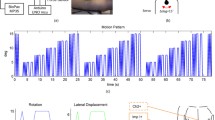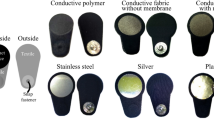Abstract
The temporal change in the approximate impedance of dry silver, stainless-steel and German-silver electrodes applied to the unprepared skin of human subjects was measured using the electrocardiogram as a test signal. In nearly all cases, it was found that “dry” electrodes are really only dry when first applied. In most cases, with the passage of time, the average electrode-subject impedance decreased; the temporal nature of the decrease was similar for all three metals. Although there were wide variations in individual impedances over a 20-min period, the average 20-min impedance was between one-fourth and one-fifth of the initial impedance for all three metals. Silver exhibited the lowest average initial and 20-min impedance values. Placing ordinary tap water below the electrodes further reduced the 20-min impedance to about one-sixth of the initial impedance.
Similar content being viewed by others
References
Barnett, A. The basic factors involved in proposed electrical methods for measuring thyroid function.Western Journal of Surgery, Obstetrics and Gynocology 1937,45, 540–554.
Bergey, G. E., Squires, R. D. andSipple, W. C. Electrocardiogram recording with pasteless electrodes.IEEE Transactions on Bio-Medical Engineering 1971,BME 18, 206–211.
Geddes, L. A. Electrodes and the measurement of bioelectric events. New York: John Wiley and Sons, 1972.
Geddes, L. A. andBaker, L. E. Principles of applied biomedical instrumentation. New York: John Wiley and Sons, 1968.
Geddes, L. A., Bourland, J. D., Wise, G. and Steinberg, R. Dry electrodes and holder for electro-oculography.Medical and Biological Engineering. In Press 1973.
Johnson, J. B. andAllred, J. E. High impedance electrocardiogram amplifier-transmitter for use with dry electrodes. Tech. Rep. SAM TR-68-55, 1968. School of Aerospace Medicine, Brooks AFB, Texas.
Lewes, D. Electrode jelly for electrocardiography.British Heart Journal 1965,27, 105–115.
Author information
Authors and Affiliations
Additional information
Supported by Grant FD 00044-02, Food and Drug Administration, Washington, D. C.
Rights and permissions
About this article
Cite this article
Geddes, L.A., Valentinuzzi, M.E. Temporal changes in electrode impedance while recording the electrocardiogram with “Dry” electrodes. Ann Biomed Eng 1, 356–367 (1973). https://doi.org/10.1007/BF02407675
Received:
Issue Date:
DOI: https://doi.org/10.1007/BF02407675




